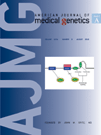Book review†
How to Cite this Article: Fraser FC. 2010. Book review. Am J Med Genet Part A 152A:2140–2141.
Genetic Rounds. A Doctor's Encounters in the Field That Revolutionized Medicine. By R Marion, editor. New York: Kaplan Publishing, 2009. 273 p.
F. Clarke Fraser OC, Ph.D., M.D., FRSC [email protected]*, * Molson Professor Emeritus of Human Genetics and Pediatrics, McGill University, Montreal, PQ, Canada.
Dr. Marion is a remarkable man. At the Albert Einstein College of Medicine he is Professor, Department of Pediatrics (Genetics), Professor, Department of Obstetrics & Gynecology and Women's Health (Reproductive Genetics), Ruth L. Gottesman Chair in Developmental Pediatrics, Chief, Section of Child Development, Department of Pediatrics, Chief, Section of Genetics, Department of Pediatrics, and Director, Children's Evaluation and Rehabilitation Center. He was trained in Pediatrics, and by virtue of a Fellowship in Genetics at Albert Einstein he is also a clinical geneticist.
This book is a series of 16 vignettes, most of which are stories about patients with rare genetic diseases, probably well known to clinical geneticists, but perhaps not to other clinicians, and certainly not to the general public. They are intended to make the reader come away with a feel for what “my professional life is like today,” Several of them feature non-genetic conditions, such as prematurity, or conjoined twins, and are not “Encounters in the Field that Revolutionized Medicine.” Only one of them involves a family history (of porphyria) that was diagnostically helpful. None of them involve what most clinical geneticists spend much of their time at—counseling about recurrence risks and what can be done about them.
The vignettes are grouped into three types. Firstly, some of the ethical dilemmas that Dr. Marion has faced, such as whether to postpone telling parents of a grave diagnosis in their child until they have had a chance to enjoy the Christmas holiday. Or whether to tell his old friend that the friend's child has a serious condition (Bardet-Biedl) that he had not been consulted about, but diagnosed on sight at a social gathering.
The second type explores some of the mysteries Dr. Marion has been asked to solve, such as a baby with botulism, or a girl with acute intermittent porphyria (just dumb luck, he says—he had been writing a story about King George III).
And thirdly, vignettes about “some aspects of life in academic medicine.” These include the satisfaction of feeling you have done some good, for instance in helping the family of an infant with trisomy 13 through his troubled life and death. Or the satisfaction of arranging prenatal diagnosis for parents of a child with a recessively inherited lethal disease, allowing them to have other children secure in the knowledge that they would not be affected.
Dr. Marion's view of a clinical geneticist's role is remarkably broad. He holds that, when caring for a child with a serious genetic disorder, the parents, sibs, grandparents, and extended family are also his patients. He weeps with the parents and for their suffering children. He goes to their funerals. He thinks that the geneticist is the logical person to provide and coordinate the continuing medical care needed by conjoined twins being separated. He does things for his patients that would usually be done by pediatricians or genetic counselors. One wonders how he manages to keep it up.
Laypersons may be entertained by this book's peek into the clinical genetics world, judging by their enthusiastic reviews. They will probably not be troubled by the fact that they are peeking at a rather atypical clinical geneticist, and they will probably enjoy the quandaries and triumphs he relates. Medical geneticists (been there, done that) may not find the book quite so rewarding.




